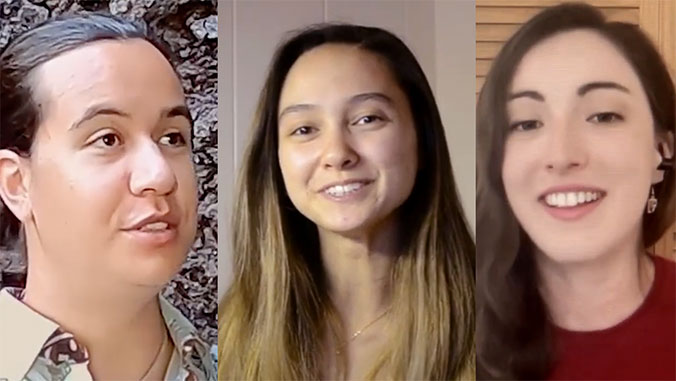
Sea-level rise computer modeling, Mars exploration and chemical compounds found on the Moon are the topics of winning videos from the University of Hawaiʻi at Mānoa School of Ocean and Earth Science and Technology (SOEST) first-annual video contest. Graduate students in the Department of Earth Sciences and Hawaiʻi Institute of Geophysics and Planetology, celebrated their research through the medium of video.
“The videos arose from a graduate course on giving professional presentations,” said Department of Earth Sciences Chair Garrett Apuzen-Ito. “The instructor, Professor Eric Gaidos, initiated this annual contest, recognizing the diverse ways in which science is being communicated. We were really pleased to see the degree of interest and outstanding talent in multimedia presentations displayed by these young professionals!”
The participants’ videos showcase the cutting-edge research they are conducting as they pursue degrees—shared in accessible language for anyone interested in science or the natural world.
This year there were three winning videos by three UH Mānoa graduate students.
Oʻahu sea-level rise maps
Through his research, Noah Paoa Kannegiesser hopes to raise awareness about energy use, plastic use and other climate change related issues. “Probabilistic sea level rise modeling using ROMS analysis” summarizes his project to create computer models of sea-level rise around Oʻahu and maps of areas that are likely to flood in Honolulu.
“What is most exciting about my research is that I attempt to look into the future and see how climate change and sea-level rise can change the coastline,” said Paoa Kannegiesser, who is from Rapa Nui. “I hope to do similar research in my home island and other Polynesian islands to see how sea-level rise might affect coastal communities and ancient cultural sites along the coast.”
Exploring Mars
In “How we see Mars,” Eleni Ravanis shared the thrill of being a team member on the Mars rover Perseverance. The rover landed on the surface of Mars in February 2021 to study Martian geology, search for signs of ancient life, collect samples for future return to Earth and prepare for future human explorers on Mars. Ravanis works on the Mastcam-Z team which assesses and interprets images from a sophisticated camera system.
“I find it really exciting to work on the Mars 2020 mission, and to look at new photographs from another world each day!” said Ravanis.
Searching the Moon for hydro-carbon compounds
Chiara Ferrari-Wong describes the hunt for an elusive class of compounds on the Moon in “Searching for hydro-carbon compounds on the Moon.” Previous studies have predicted the presence of hydrogen-carbon compounds on the Moon but they have not yet been detected on the lunar surface. Ferrari-Wong shares the process by which micrometeorites that strike the Moon’s surface can melt the surrounding soil—creating glass and trapping compounds. These glass particles may provide a vault that preserves these cryptic volatile compounds.
When asked what impact she hopes to make, Ferrari-Wong replied, “I hope to share my love of planetary science with the community and inspire young students to pursue careers in science, technology, engineering and math.”
This effort is an example of UH Mānoa’s goal of Enhancing Student Success (PDF) and Excellence in Research: Advancing the Research and Creative Work Enterprise (PDF), two of four goals identified in the 2015–25 Strategic Plan (PDF), updated in December 2020.
For more information see SOEST’s website.
—By Marcie Grabowski

